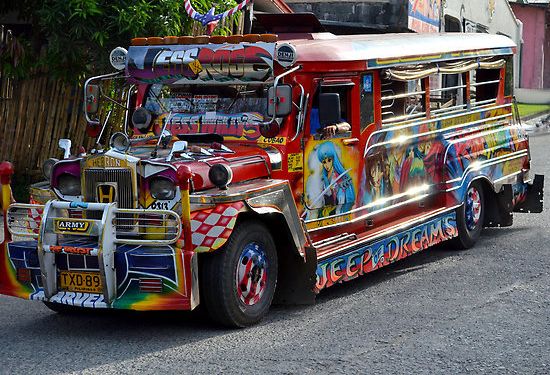
philippines jeepney
For western travelers, the Philippines is a great place to experience Southeast Asia. With a vast population of English speakers, you’re less likely to feel lost and confused wherever you decide to go. But to ensure that everything goes smoothly, you need to do your research way before your flight. Aside from letting you act like a local traveler, getting along with the residents will also let you explore more easily.But while you could book a private taxi in most metropolitan areas, there’s a much more affordable way to get around the country: the Philippine jeepney.
What is the Philippine Jeepney?
Over the years, Filipinos have used their resourcefulness to transform surplus U.S. military jeepneys into the country’s most popular mode of transportation.You don’t have to look far to find one of these brightly-colored vehicles on the road. But you can’t just climb into one without knowing the proper etiquette, often made up of many unspoken rules. It involves a lot more socializing than you’re probably used to with other commuting methods. Plus, you need to follow a very specific process so as not to offend the locals. Read on to find out more about how to master the art of commuting via jeepneys.
Knowing Your Fare
Before getting onto the jeep, you can ask jeepney drivers how much your fare will be. To save time, ask your hotel receptionist how much a trip to your destination costs so you can prepare money in advance.However, make sure to use smaller bills, as it’s frowned upon to hand over a PhP 500.00 or PhP 1000.00 bill. If you can, prepare the exact fare in coins so that you can save the driver the hassle of scrounging for your change. Remember: the driver is usually the one computing and handling the payments, all while driving! The less work you give him, the safer your ride will be. You won’t have to wait around for your change, either, so you can focus on enjoying the ride.
Getting into the Jeepney
Don’t clamber into a jeepney expecting an incredibly spacious ride, as these vehicles will make you feel like you’re stuck in a can of sardines. Most jeepney drivers will try to accommodate more people than can be comfortably seated. If you’re the last person to get on, you’ll need to squeeze yourself into whatever tiny seating space is left. Otherwise, you’ll have to wait for the next available jeep. If you really want a little more room, try offering to pay the driver some additional fare for the extra space. This also works in case you have bulky baggage that you’d like to keep beside you at all times. Hold on to the safety bar, too, as the ride can be a bit rough at times.
Handing Over Your Fare
When you’re finally in the jeep, you may notice the unusual way they collect the fares. In order to pay the driver, you pass your money forward while saying “bayad po” to indicate that it’s your payment. Another person in the jeep—usually closer to the driver—will pass it on. Just before your money reaches the driver, announce where you plan to get down, as well as how many people you are paying for. The driver will hand your change over to the passenger sitting closest to him. Said passenger will take your change and pass it along the jeep until it finally reaches you. Don’t forget to say “salamat po” to show your gratitude for the other passengers’ help.
Handing Over Other People’s Fare
In jeepneys, paying for fare and getting change is a group effort. When other people are paying, you have to show them the same courtesy that they show you. Don’t ignore anybody trying to pass their fare to the driver, as it’s considered extremely rude to do so. When somebody hands you their payment, they will either say “bayad po” or “pakisuyo lang po” (the equivalent of saying “please.”) When you hand the fare over to the driver, say “bayad daw po” to indicate that it’s another person’s payment, not yours.When you’re passing change back down the line, you can say “sukli daw po” to get the attention of the person it’s for.
How to Get Down at Your Destination
If you know where you’re disembarking, call out “Para!” (Stop!) or “Sa tabi lang po!” (a way of indicating that it’s your stop).Do it just loudly enough for the driver to hear you, but not so loud that you scare the wits out of everybody else.However, it’s acceptable to say this a little louder if you’re in a particularly noisy area. While not necessarily a requirement, it is also polite to thank the driver for getting you to your destination.
Other Ways to Alert the Driver of Your Destination
If the driver can’t seem to hear you, you can tap a coin on the safety bar to alert them of your stop. You can also knock on the inner roof of the jeepney. However, some consider these gestures to be rude, so only do these if the driver hasn’t heard you after multiple attempts to get their attention. If you’re lucky, the jeep you’re in may have a string along the roof, with a sign that says “Pull the String to Stop”. In that case, you can try pulling that first to alert the driver.You’ll see a light come on, or hear an amusing sound effect blare from somewhere in the vehicle.
How Not to Miss Your Stop
Make sure to give the driver enough time to slow down and come to a halt. Do this by alerting him while you’re still a block away from your destination, or you might miss your stop entirely. Most of the time, jeepneys won’t stop at your exact destination to because of strict traffic laws regarding official loading and unloading areas. Don’t insist on getting off at an undesignated stop, either, as this could get the driver in trouble with the authorities.
Become the Master of Commuting
Riding a jeepney is, without a doubt, a unique experience that you have to try for yourself if you’re traveling the Philippines. Keep all of these tips in mind so that you can do it the right way once you’re in the country. You’ll save yourself a lot of time, and will save yourself from a lot of potential embarrassment, too.
